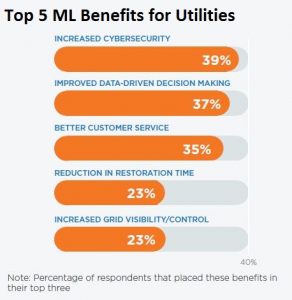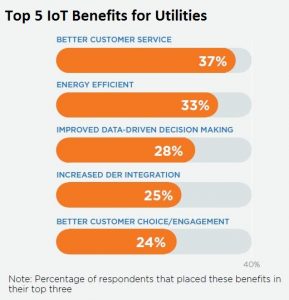Research indicates that IoT and Machine Learning are more valuable to utilities when used in combination but there are hurdles to overcome first.
Machine learning and IoT will enable utilities to better realize the next generation of the power grid: a distributed system with power flows among millions of things like distributed energy resources (DERs), microgrids and in-home devices. All of which will help utilities deliver clean reliable energy and greater customer choice.
Utility respondents to new research from SAS and Zpryme, The Autonomous Grid, indicated that IoT and machine learning were more than market hype. These technologies are already delivering actionable results, say respondents. However, when we asked about the benefits of investing in IoT and machine learning, we received very different responses across those two technologies.
The top benefits associated with IoT are more likely to be customer-facing, such as customer service and energy efficiency, whereas the benefits named for machine learning are more grid-oriented, including areas such as service restoration, increased grid visibility/control and cybersecurity (Figure 1,2 Benefits).
The utility-specific research evaluated the maturity of these technologies separately, but the survey and interviews indicated that IoT and machine learning may be most valuable when implemented together.
As this video above portrays, utilities can reap significant benefit from analytics on IoT data. Analyzing data from connected sensors provides more accurate insight on power quality, improved processes for power restoration, and increased safety and awareness for crews working on active and downed power lines. 53% of respondents said they already knew how IoT was benefiting their business.
The next level of value comes from the application of machine learning within the IoT environment. For example, deploying the predictive model of transformer failure at the edge device that can reroute the power to minimize or prevent interruption. Only 20% of respondents had a firm grasp on machine learning benefits.
“There are going to be so many IoT devices out there that we’ll have to develop machine learning or analytics that can take into account the sheer volume of data,” said Kevin Lagge, Director, Strategy, Analytics, Enterprise Architecture and Technology Planning, Oklahoma Gas & Electric (OGE). “It’s critical, from the standpoint of the volume of information we’re going to have in the future, that machine learning is developed. We’re not going to be able to have a human interface every time we want something to improve.”
“There are going to be so many IoT devices out there that we’ll have to develop machine learning or analytics that can take into account the sheer volume of data.” Click To TweetSRP views the IT/OT integration as “the gateway” to machine learning and advanced analytics. “You can’t implement full machine learning without having a seamless IT/OT set-up,” said Rob Kondziolka in an interview with Zpryme on behalf of SAS. “Only then we can really focus our time on decision making, and that’s what we all want to do – be able to make the right decisions based on the best available data and guidance you’ve got.”
Vision is one hurdle, but talent is another. “I think part of the challenge is expertise, and then part of it is partnerships,” said Randy Vance, eServices Manager, Kansas City Power and Light (KCPL). “A lot of competitive industries may have data scientists on board, but that’s not something that’s necessarily a typical job description here. … [It’s] also going to be very important that we make the right choices in partners that can bring in that kind of expertise.”
Given these insights, can the “digital grid” momentum persist long enough to see machine learning algorithms implemented on IoT data?
Theirry Godart, General Manager of Energy Solutions at Intel, believes the answer is yes. He says, “The most concerning issue remains the decision to get started while knowing that innovation is on the way and current technology will be obsolete very quickly. Once everything is connected, big data analyses will unlock the business value for all stakeholders.”
Analytics are augmented by new data and evolve regardless of the underlying technology infrastructure. So make sure that machine learning gets an invite to your utility’s IoT party. It will be a better experience when IoT and machine learning are together!
For the complete research results, visit The Autonomous Grid: Machine Learning and IoT for Utilities


